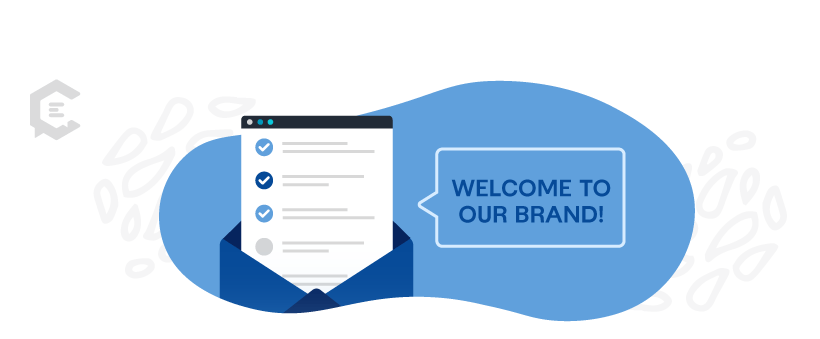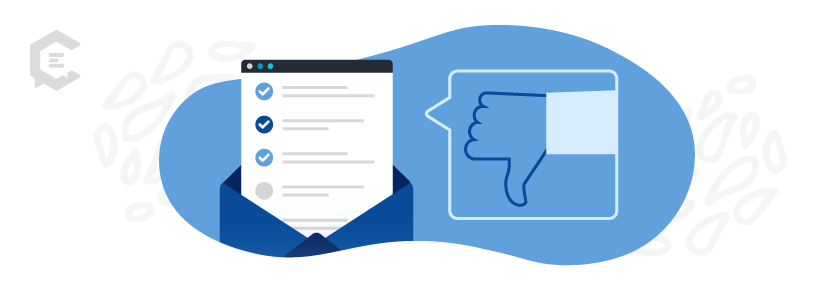In digital marketing, gaining a new customer or securing a purchase is a common goal. However, it’s not enough to simply snag their information and call it a day.
Instead, the most influential strategists guide users through every step of their customer journey via calculated onboarding emails.
You can think of these as a journey a brand takes with everyone who comes in contact with them, hopefully resulting in a lifetime relationship. When companies invest in these calculated and timed touchpoints, they see increased retention, loyalty, and satisfaction.
Here, a guide to onboarding emails, including top do’s and don’ts and concrete examples from stellar brands:
Onboarding emails are an important first impression
Eileen Gilbertson, the head of marketing for Meetup, says that onboarding emails are how you welcome your audience to your brand.
As she explains, it begins your relationship with each other and is a vital piece in a user’s lifecycle, and it creates a direct communication between the brand and your desired audience — whether that is a potential or new customer, client, partner, or anyone that your brand has a reason to communicate with regularly.
“An onboarding email should be welcoming, reflective of the brand, and quickly convey its value to the person receiving it,” she continues. “The more you know about your audience, the better you can segment, personalize, and speak directly with the values that will connect to them, setting the audience up for long-term retention. It’s your first step to nurture the connection between your brand and the recipient, and you want to make a great first impression.”
Why are onboarding emails a vital part of content marketing?
When you think about the companies you support and return to time and time again, it’s likely because they’ve gained your trust.
Whether through a quality product or dependable customer service, they somehow made a lasting impression on you. Gilbertson says this is where onboarding emails can make or break a relationship.
“Much like in life, your onboarding email’s first impression has a similar impact. The recipient will have an immediate reaction to your welcome email,” she shares. “If your welcome email is successful, it can lead to an immediate conversion or action from the recipient and hopefully lead to a long-term relationship. If it hits the wrong note, though, it could lead to an unsubscribe, or worse, the recipient choosing never to come back.”
The 5 do’s of onboarding emails
The keyword here is ‘emails’ — meaning more than one. You want these messages to be targeted, go through a specific series, and overall, lead to continuous engagement. That’s why following these five do’s will help set you up for success:
- Do get to know your brand and your audience.
- Do meet expectations through a series of emails.
- Do provide a call to action.
- Do test and continuously optimize onboarding emails.
- Do offer helpful information and resources.
Do get to know your brand and your audience
Choosing your words wisely is crucial in nearly all dynamics, but in your onboarding emails, it’s smart to tread carefully and be precise, says Gilbertson.
As she explains, each word needs to make an impact and be integral to your storytelling.
“The verbiage you use needs to align with your brand’s voice well. How you communicate with your audience will set the tone for their entire journey,” she explains. To know how to speak to your community, she says it’s vital to know them.
“Segment your sends and ensure each touchpoint with the information that you have. Trust with your audience is ever-evolving, and your relationship with your audience is built on this first foundation of connection,” she says.
Do meet expectations through a series of emails
Once you design and write your onboarding emails, they usually become automated based on a customer’s action. Did they leave something in their cart? Did they make one sale and never return? Did they leave a review? Did they complete their profile?
No matter the purpose of the email, it’s vital to meet the customer’s expectations by answering their questions, says Adam Q. Holden-Bache, the director of email marketing for Enventys Partners.
“Make these emails all about the value someone will receive if they choose to do business with you or the benefits of a product or service they have already purchased,” he recommends. “What did you offer in exchange for the subscriber’s email address? If you don’t deliver on what you promised, you’ll immediately lose the subscriber’s attention. It is extremely difficult to recover from that later.”
Do provide a call to action.
For effective onboarding messaging, the reader needs a singular focus that guides them toward the next step. As Gilbertson says, this requires marketers to identify the next move you want them to make and how you will provide immediate value for that action.
“This email is the first step in a long-term relationship with the recipient. Your goal should be to set them up not only for the next step but also for long-term success that will lead to a vibrant relationship with your audience,” she explains.
Do test and continuously optimize onboarding emails.
If you aren’t testing, you’re not evolving. And more importantly, you aren’t taking the critical time required to understand what your customer truly needs and desires.
As Rekha Gibbons, the chief operating officer of Raare Solutions says, subject line, content, images, and CTAs benefit most when subjected to live consumer testing.
“Monitoring the performance of your onboarding campaign helps you identify opportunities for improvement,” she continues. “One good place to start is by looking at low-performing campaigns. Determine what onboarding programs have low activity and conversion rates. Then, conduct A/B testing to remove clunkers from your program and improve engagement.”
Do offer helpful information and resources.
Despite a consumer actively choosing to interact with your brand, they may require reminders of your product or service’s value and function, reminds Gibbons.
Additionally, depending on your product’s nature and complexity, customers may also need additional help navigating through the onboarding process.
“This provides an excellent reason to guide troubleshooting, utilizing advanced features, or getting the most value out of your core features,” she shares.
How do you do this? Through how-to videos, blog links, FAQ, customer support, and linking to live chat. As Gibbons says, this reinforces the message that the customer is important and that your brand is willing to provide the tools they need upfront.
5 don’ts of onboarding emails
Onboarding emails can have the opposite intended impact if they come across as too sales-focused or not customer-centric. To ensure your investment in this digital marketing tactic is meaningful, avoid these key mistakes:
- Don’t try to be everything to everyone.
- Don’t think the customer’s journey ends at the point of sale.
- Don’t overwhelm your new subscriber.
- Don’t take the customer out of the equation.
- Don’t hold onto your best stuff.
Don’t try to be everything to everyone.
You won’t fulfill every last question and desire from each customer 100 percent of the time. And that’s okay! Rather than trying to meet an impossible list of ‘could be,’ Gilbertson says it’s more helpful to be specific and narrow your focus so you can address your audience’s needs and nurture those leads into a long-term relationship.
“You need to know your audience and speak to them clearly. What is the value they are seeking? What is their need? Write to that connection,” she says.
Don’t think the customer’s journey ends at the point of sale.
In fact, Gibbons says the exact opposite is true. Instead, the journey begins as soon as the consumer clicks ‘purchase’ or ‘subscribe.’ “This means the entire journey from acquisition to nurturing and retention must be carefully mapped.
Continuous wooing is required for the entire journey with your brand; otherwise, the customer will churn and possibly defect,” she continues. “The first few weeks of a customer’s journey with your brand are the most crucial, so make them work to your benefit.”
Don’t overwhelm the new subscriber.
It’s one thing to receive an email welcome at noon the next day after you purchase or subscribe, and it’s another to be sent four emails in 24 hour period. Or for all of those emails to be super long and confusing.
To avoid overwhelming the new subscriber, Holden-Bache recommends keeping content short and concise, and, if necessary, to break things up into additional shorter messages.
“If you see email metrics drop off at a certain point, try extending the time between messages or revising the message topic and subject line,” he adds.
Don’t take the customer out of the equation.
While the onboarding email’s objective is to provide rich information about a product or service, Gibbons reminds the customer that the focus should remain. This requires making every second they spend with your brand entertaining, helpful, and worth reading.
“And that means an email chock full of value. Help the customer achieve something fast: links, downloads, click to call, click to chat, and so on,” she says.
Don’t: Hold onto your best stuff.
Edgar Walker, the director of growth at Front Office Sports says some marketers feel they should hold onto their best content until a user is more familiar with their product/brand.
But, while there’s value in familiarity before pushing a subscriber into something transactional, a new subscriber’s interest is likely at its highest right at the moment of sign-up.
“Use that interest as permission to showcase some of your best work or any add-ons to the subscriber experience,” he says.
3 examples of great onboarding emails
The best way to create killer onboarding emails is to learn from great examples. Here, three top recommendations from our experts:
- Physician’s Weekly newsletter series.
- Dollar Shave Club’s clever tactic to streamline engagement.
- Brooks Running Shoes personalize touch.
Physician’s Weekly newsletter series.
“For each of their conference newsletter series, the first newsletter is a welcome and kick-off announcement about the conference, what to expect, and includes branding from the conference.
For example, suppose they are covering ASCO, the American Society of Clinical Oncology annual meeting. In that case, the ASCO logo will be included for fast and easy reference for these busy first responders.
This welcome email outlines the therapeutic coverage that can be expected in the coming days during real-time coverage of the medical conference. Each conference email series wraps up with a clinical challenge, the PhysQuiz, testing readers on the news from the conference and appealing to physicians’ inherent competitive nature among their colleagues. I’m told that these types of tailored newsletters by Physician’s Weekly results in audience engagement that surpasses industry standards,” Gilbertson shares.
Dollar Shave Club’s clever tactic to streamline engagement.
“While the email tells the subscriber what their next package will contain, they offer an upsell as well: ‘Toss in more before we ship?’ And to sweeten the pot for the razor-obsessed, there’s a link to the entire online store. This email is outstanding for several reasons. First, it confirms the customer’s order and takes time to verify the customer’s shipping address. Perfect for the newly onboarded customer. Then it offers options to tweak the criteria the customer originally chose: the item, the quantity, and the shipping frequency. At the very bottom of the email is a credit list the customer has accumulated and how many they could have if they invited a friend. In this case, $5 for every friend referred,” Gibbons shares.
Brooks Running Shoes personalize touch.
“This onboarding email series is really great because it allows the recipient to express their interests, which Brooks should then use to deliver more personalized content. So male trail runners will have a different email experience than females who focus on gym workouts. I also like the call-to-action of ‘Explore all Brooks gear’, which is inviting and not pitchy. The idea of “exploring” a new brand is a nice touch. A ‘buy now’ approach would have set the wrong tone in an onboarding email,” Holden-Bache shares.
Need help writing onboarding emails for your customers? Talk to a content specialist at ClearVoice today to get started.







